
Sony Has a SERIOUS Problem
Nov 18, 2025Get the full story watching the video above ⬆️
Purchase:
iPhone 17 Pro (affiliate) - https://geni.us/zrzT
Sony a6700 - https://geni.us/Ik0rX
1.0 Introduction: The Convergence of Computational and Traditional Imaging
This analysis examines two distinct and increasingly overlapping philosophies in modern digital imaging. It is not a direct competition between devices, but rather an exploration of their core approaches. The Apple iPhone 17 Pro represents the zenith of integrated, computationally-driven photography, where the camera is a primary function of a powerful, all-in-one device. In contrast, the Sony a6700 embodies the adaptable, hardware-focused interchangeable lens camera system, a specialized tool designed for creative flexibility. This document provides a detailed, evidence-based evaluation for product and marketing strategists, based solely on the provided technical reviews and specifications, to understand the capabilities, target users, and market positioning of each device.
The analysis begins by defining the core design philosophy and target market for each system. It then moves to a comparative breakdown of their foundational hardware—the sensors and optics—before diving deep into key performance features like autofocus, still imaging, and video capabilities. The report concludes with an assessment of ergonomics and user experience, culminating in a strategic synthesis of each product's unique position in the digital imaging landscape.

2.0: Core Philosophies and Target Markets
Understanding a product's core philosophy is of paramount strategic importance. This foundational approach dictates every subsequent design choice, from hardware specifications and software features to the overall user experience. Ultimately, it is this philosophy that defines the product's value proposition and its intended target market.
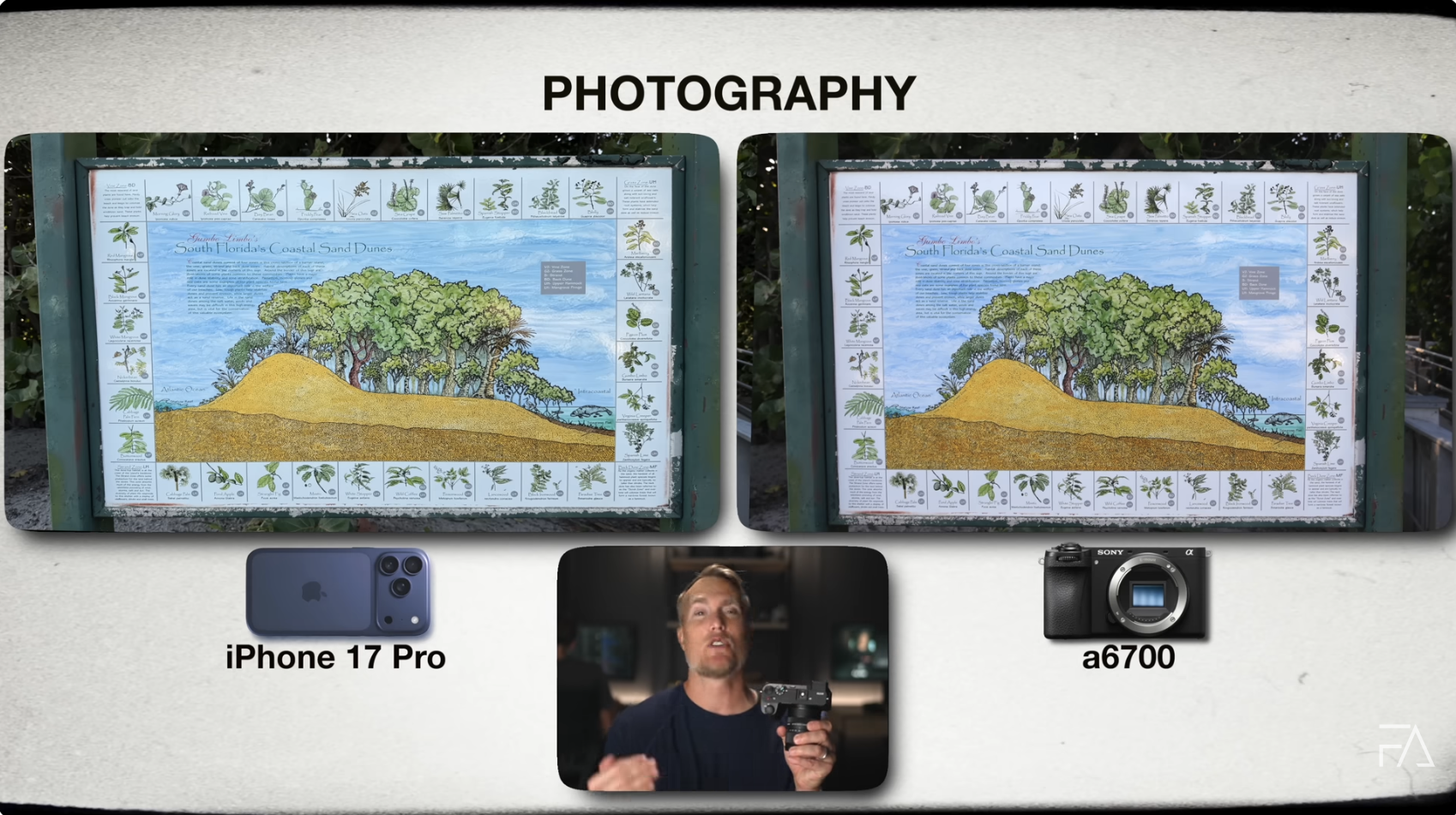
2.1 Apple iPhone 17 Pro: The All-in-One Computational Powerhouse
The iPhone 17 Pro's core philosophy is that of a "workhorse" device where the camera is a primary, deeply integrated function rather than a standalone component. It is engineered as the ultimate convergence device, leveraging the immense processing power of its A19 Pro chip to deliver professional-grade results within a seamless software ecosystem. The target user profile is explicitly defined as professionals, content creators, and demanding users for whom the phone is their "most important camera." As one review notes, this device is made for "people who actually use their phones professionally," prioritizing an all-in-one solution for capture, editing, and distribution.
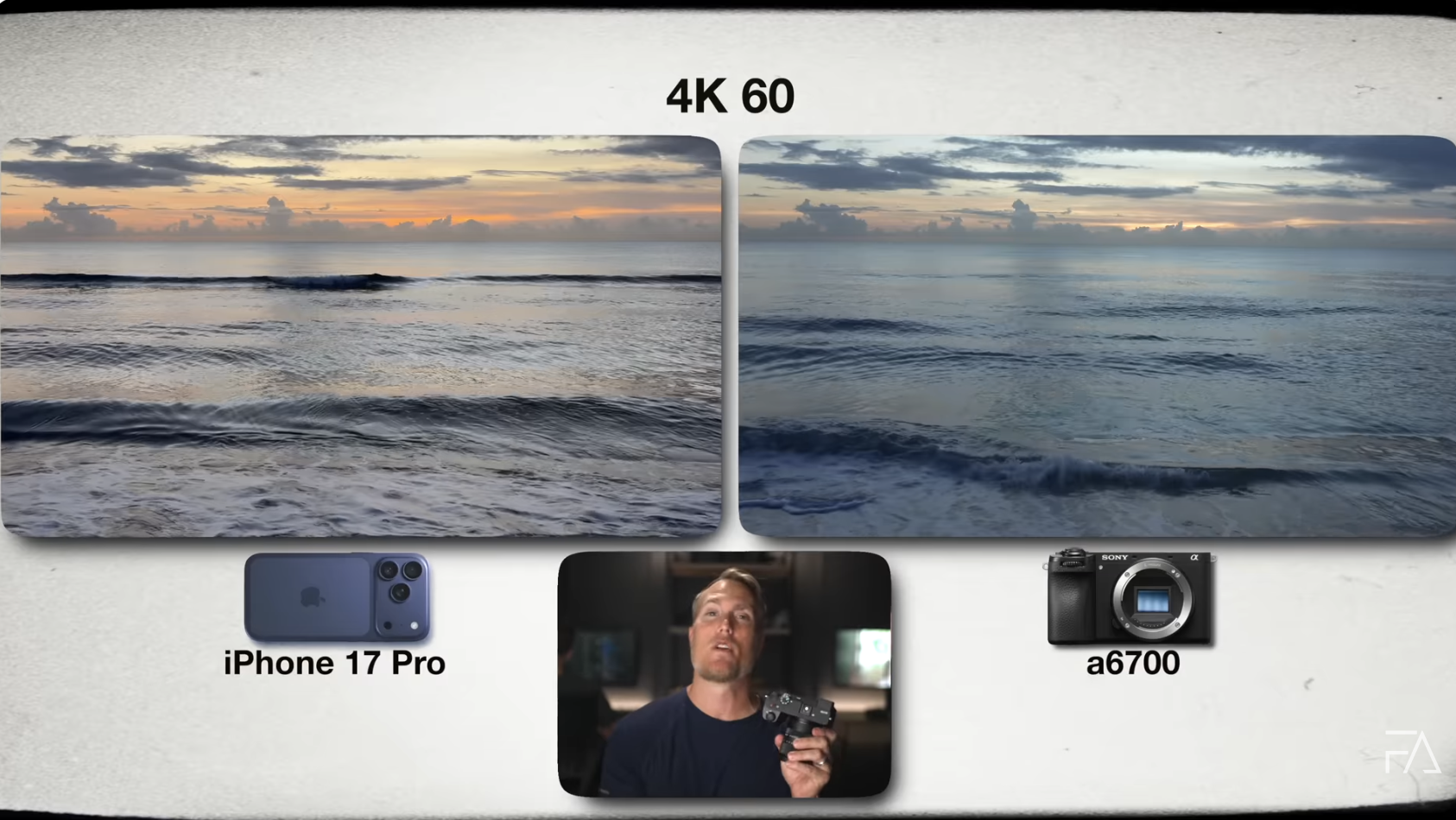
2.2 Sony a6700: The Specialized Hybrid System
The Sony a6700 follows the philosophy of a specialized, enthusiast-level tool designed for users who prioritize creative control, optical flexibility, and advanced performance in a dedicated camera body. It is a hybrid system built for both high-end photography and videography, offering granular physical controls and the vast adaptability of an interchangeable lens mount. Its target user profile includes "street photography" hobbyists and "freelance videographers" who willingly accept a more deliberate, traditional workflow—transferring files from an SD card and post-processing on a computer—in exchange for granular control and optical precision.
|
Apple iPhone 17 Pro |
Sony a6700 |
|
Core Value: State-of-the-art computational imaging and a seamless pro ecosystem in a single, portable device. |
Core Value: Uncompromising creative control through optical versatility and a class-leading, hardware-driven autofocus system. |
Having established these high-level philosophies, the analysis will now examine the specific hardware that enables these distinct approaches.
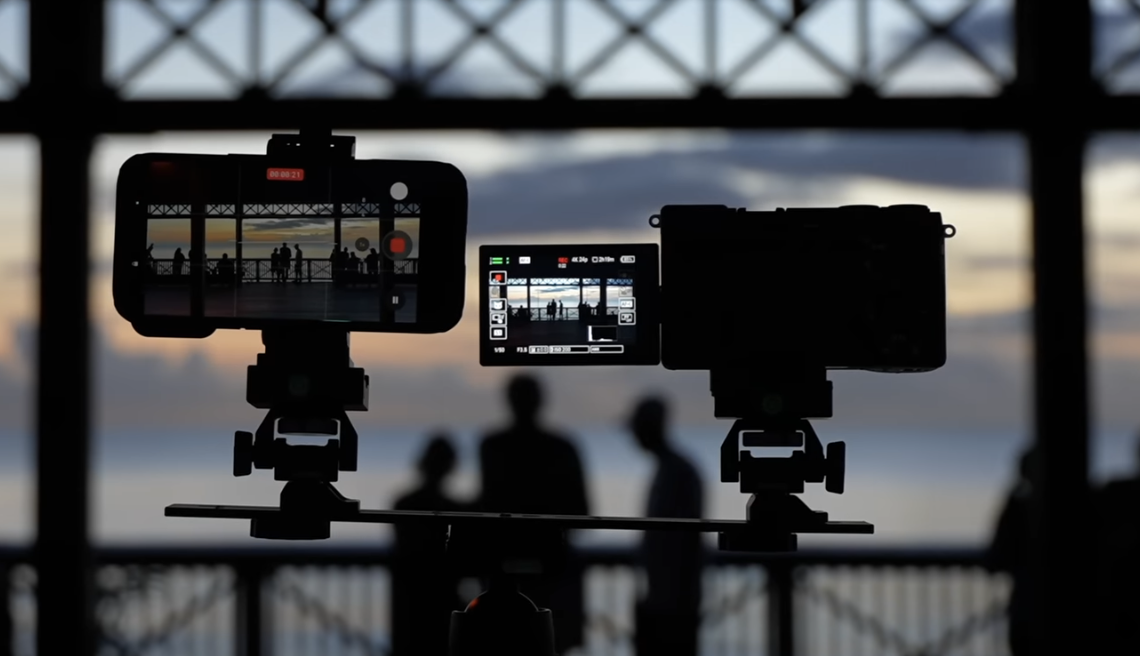
3.0 Comparative Hardware Analysis: Sensor and Optics
The fundamental differences in sensor and lens architecture are the primary drivers of each device's distinct imaging capabilities and limitations. Dissecting these core hardware components provides a foundational understanding of their performance potential and the strategic choices made by each manufacturer.
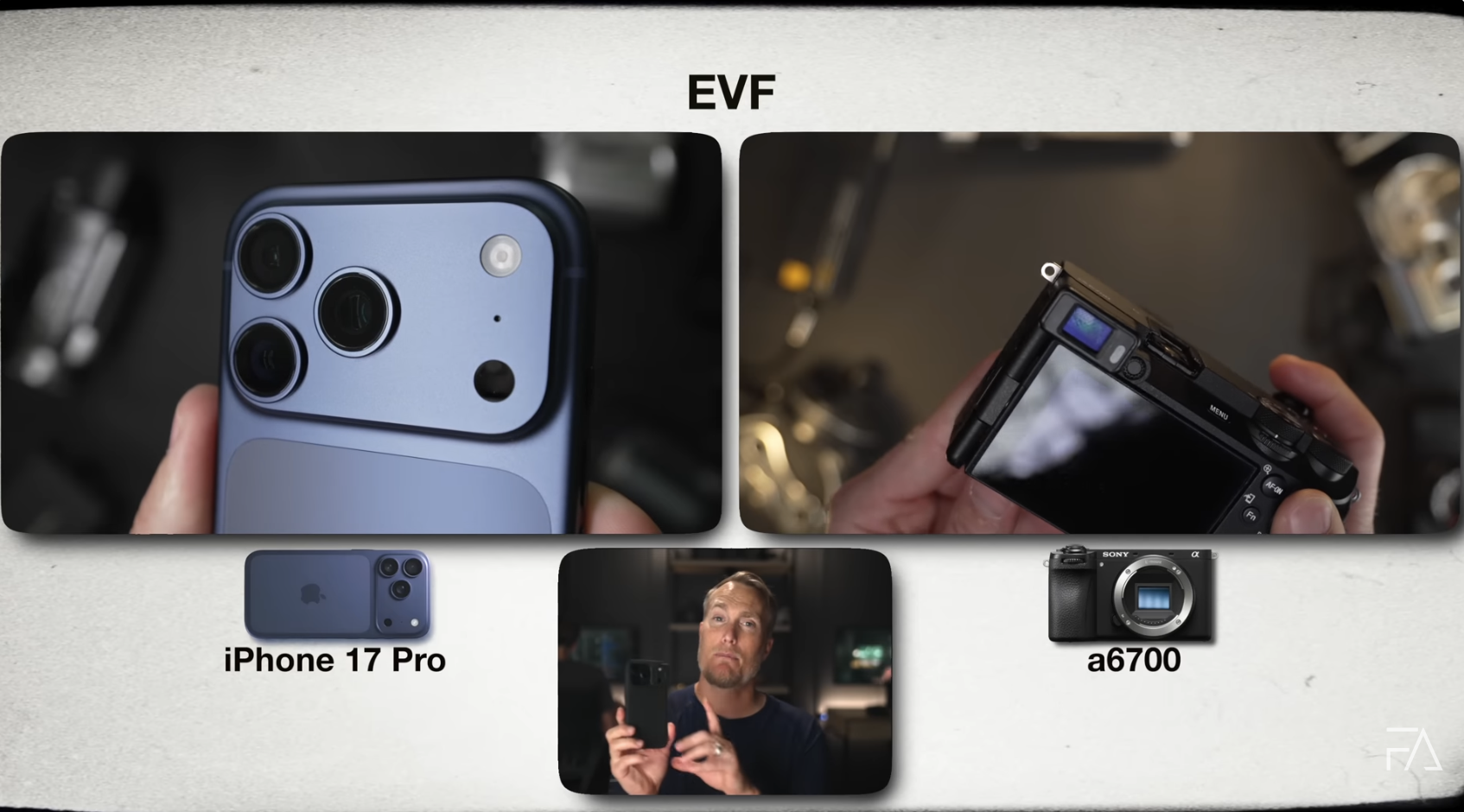
3.1: Sensor Technology
The sensor is the heart of any digital camera. The iPhone 17 Pro employs a multi-sensor system to achieve its versatility, while the Sony a6700 relies on a single, much larger sensor.
|
Feature |
Apple iPhone 17 Pro |
Sony a6700 |
|
Sensor Type |
Multi-sensor "Pro Fusion" system |
Single Exmor R CMOS sensor |
|
Sensor Dimensions |
Main, Ultra Wide, and Telephoto sensors; Telephoto sensor is 56% larger than predecessor; 24MP square front sensor |
APS-C (23.3 x 15.5 mm) |
|
Effective Megapixels (Stills) |
48MP (Main), 48MP (Ultra Wide), 48MP (Telephoto) |
Approx. 26.0 megapixels |
|
Key Differentiator |
A multi-sensor array where computational processing, not sensor size, is the primary driver of versatility. |
A single, large APS-C sensor optimized for traditional optical performance. |
The strategic implications of these sensor designs are profound. The Sony a6700's large APS-C sensor provides inherent optical advantages. Its crop factor results in a deeper depth of field relative to the full-frame format (e.g., an f/2.8 aperture provides an f/4.5 equivalent depth of field), a characteristic noted as a specific benefit for genres like street photography where a larger zone of focus is often desired. In contrast, the iPhone 17 Pro relies on its powerful computational pipeline and multiple smaller sensors to simulate such optical effects, offering convenience at the cost of native hardware performance.
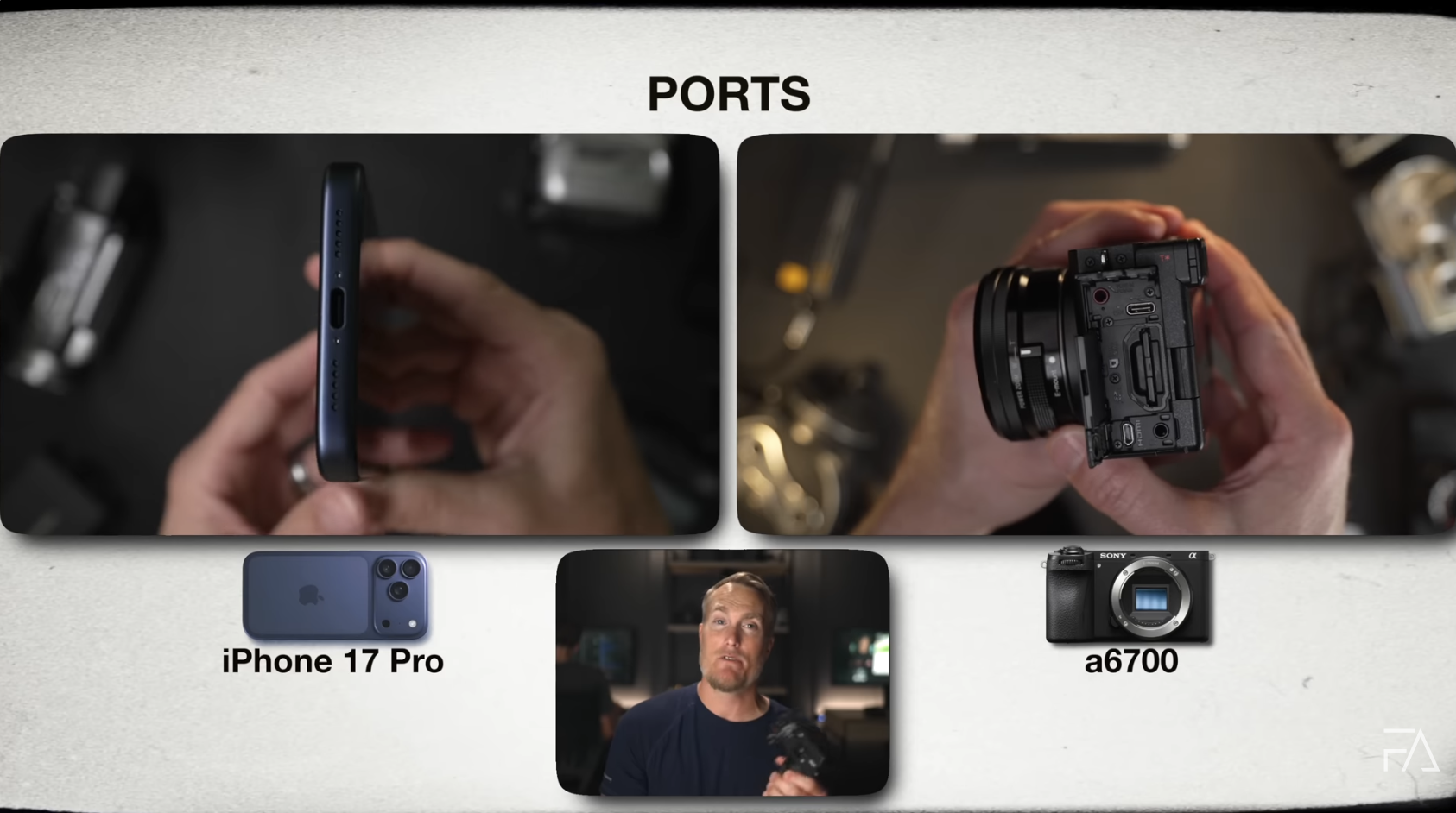
3.2 Lens Systems and Versatility
The two devices represent opposing philosophies in lens system design: one integrated and fixed, the other modular and interchangeable.
• Apple iPhone 17 Pro: The device features a fixed, integrated three-lens system with native focal lengths of 13mm (Ultra Wide), 24mm (Main), and 100mm (Telephoto). Apple markets this as "like having 8 pro lenses in your pocket," a claim built upon the use of "optical-quality" center crops from the 48MP sensors to create additional focal lengths, notably at 2x (48mm) and 8x (200mm). However, reviews note a key limitation: the Main camera lacks the close-focusing capabilities of other models like the iPhone Air, creating a user experience annoyance for common, arms-length photography.
• Sony a6700: The camera is built around the E-mount interchangeable lens system. This offers the user immense flexibility, providing access to a vast ecosystem of first-party and third-party lenses tailored to specific needs, from wide-angle architectural shots to super-telephoto wildlife photography. The camera body itself provides no optical capability without a lens attached. All lenses are subject to the APS-C sensor's 1.5x crop factor, which provides an equivalent field of view (e.g., a 20mm lens behaves like a 30mm lens in full-frame terms).
These hardware capabilities directly inform the performance-driven features, such as autofocus and video, which we will explore next.

4.0 Performance and Feature Deep Dive
Raw hardware is translated into tangible performance through advanced processing and software integration. This section critically evaluates key performance areas—autofocus, still imaging, and video capabilities—to determine the practical strengths and weaknesses of each system in real-world use cases.
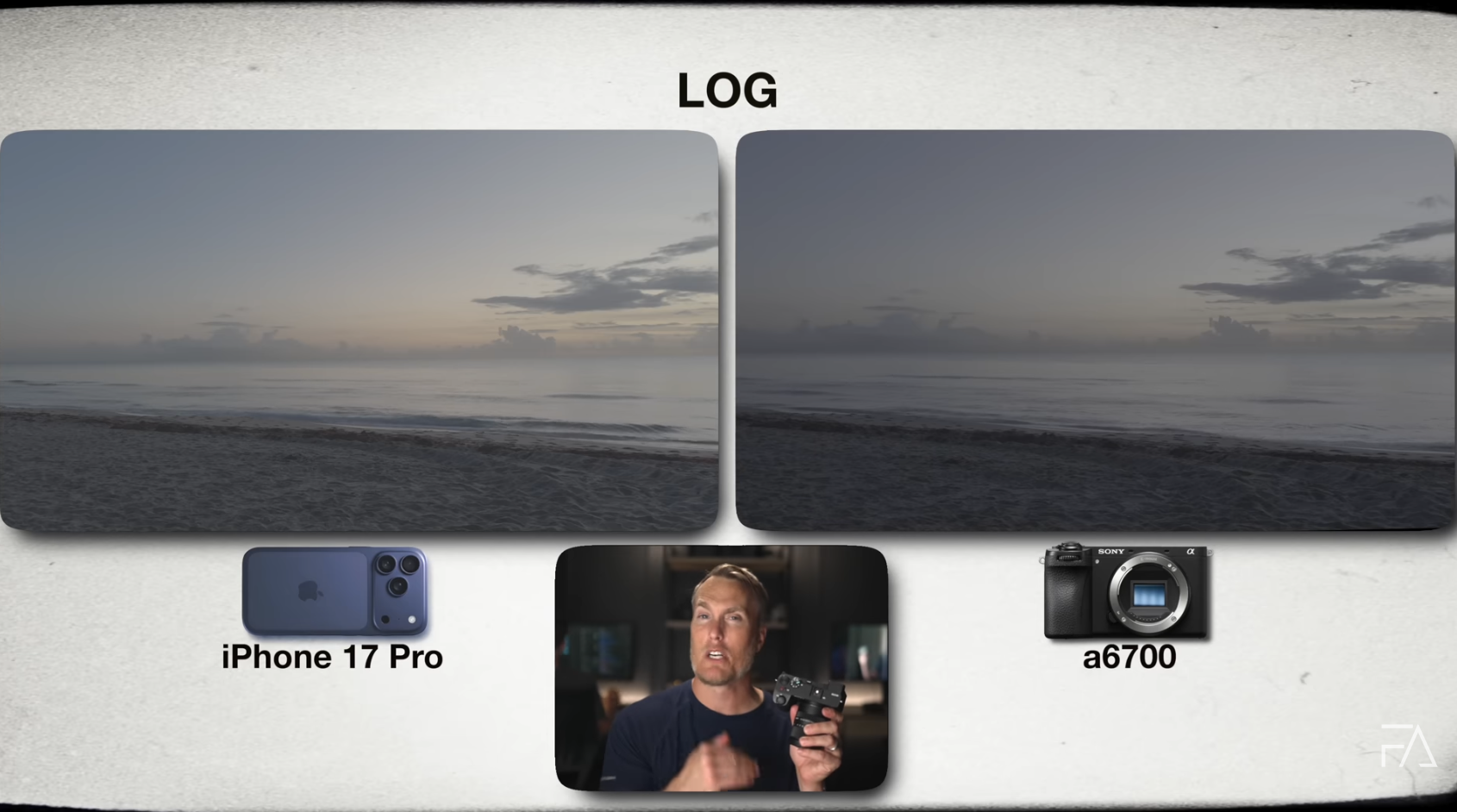
4.1 Autofocus (AF) System Evaluation
• Sony a6700: The a6700 is praised for its "best-in-class" Fast Hybrid AF system, which features 759 phase-detection points and a dedicated 'AI Processing Engine.' This system is explicitly trained to recognize and track a wide range of subjects, including Human, Animal, Bird, Insect, Car, Train, and Airplane. Reviews describe its tracking performance as phenomenal, noting that the focus box sticks to subjects "like glue" with a "near-perfect hit rate," making it a standout feature for capturing fast-moving or unpredictable action.
• Apple iPhone 17 Pro: The iPhone's autofocus capabilities are deeply integrated with the A19 Pro chip and its computational processing pipeline. While highly effective for general use, the system's specific subject-recognition capabilities are not detailed with the same level of granularity as Sony's, relying instead on the phone's overall processing intelligence to identify and maintain focus.
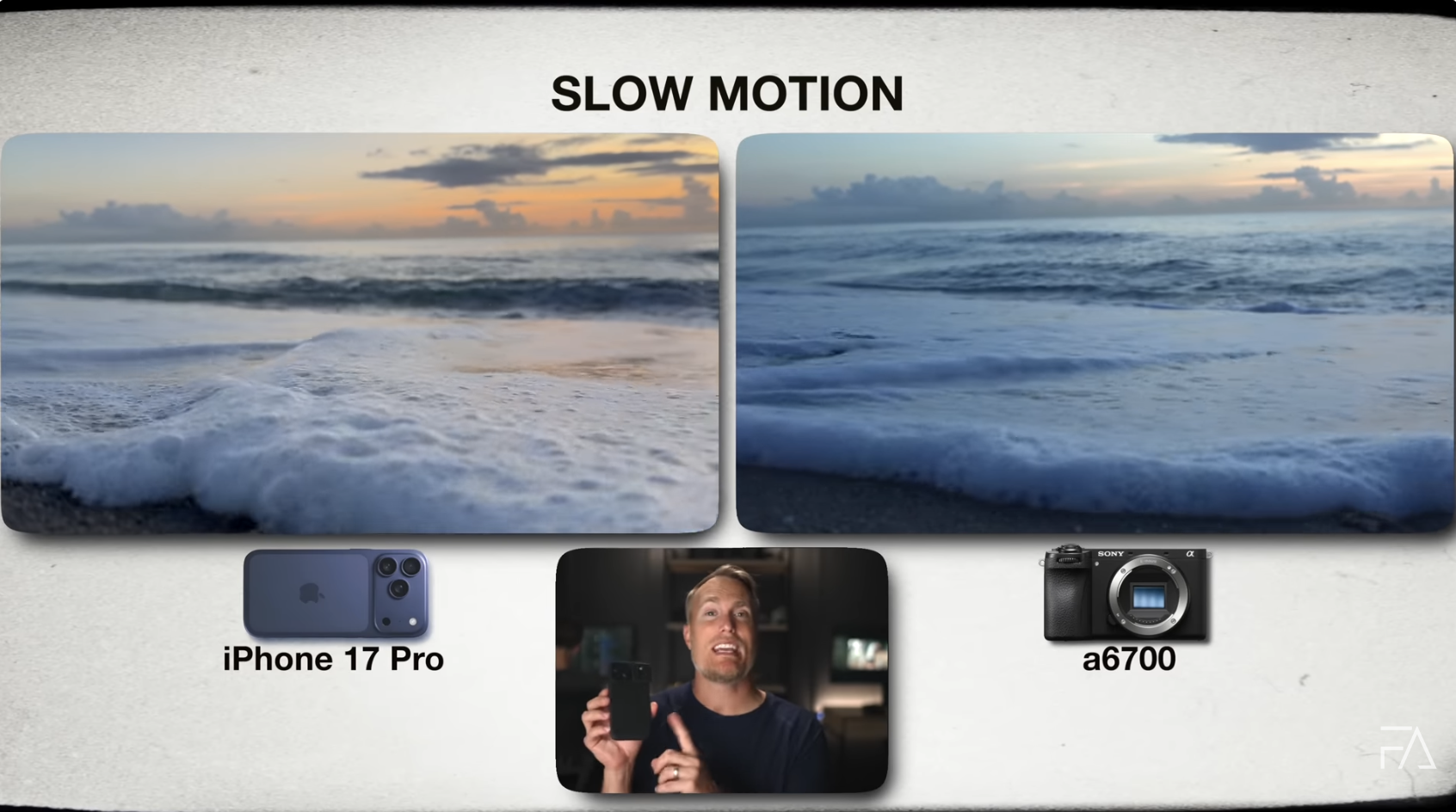
4.2 Still Image Capabilities and Workflow
The approach to still image capture and file management highlights the divide between a mobile-first and a traditional camera workflow.
|
Feature |
iPhone 17 Pro |
Sony a6700 |
|
RAW Format |
Apple ProRAW (combines image processing with RAW data flexibility in the native app) |
14-bit RAW (Sony ARW 4.0 format) |
|
Image File Formats |
HEIF, ProRAW, JPEG |
RAW, JPEG, HEIF (4:2:0/4:2:2), RAW+JPEG, RAW+HEIF |
|
Continuous Shooting |
Not specified, but leverages computational power for burst modes. |
Up to 11 fps with mechanical or electronic shutter |
|
Computational Features |
Night Mode, Photographic Styles, Deep Fusion, AI-driven demosaicking and upscaling |
HLG Still Image mode (for HDR HEIFs) |

4.3 Video Capabilities and Workflow
Both devices offer professional-grade video features, but their workflows and limitations differ significantly.
• Apple iPhone 17 Pro: Its pro video feature set is designed for seamless integration into professional and content creator workflows. Key features include:
◦ ProRes RAW support, an industry-leading codec.
◦ Apple Log 2 for wider color gamut and grading flexibility.
◦ Genlock support for synchronizing video from multiple sources.
◦ 4K 120 fps Dolby Vision recording.

• Sony a6700: The a6700 delivers outstanding video quality with features aimed at videographers who prefer a traditional camera workflow. Its capabilities include:
◦ 4K/60p video oversampled from a 6K capture for exceptional detail.
◦ 4K/120p video from a 1.58x sensor crop.
◦ 10-bit 4:2:2 internal color recording for professional grading.
◦ S-Log3 and S-Cinetone picture profiles.
◦ The ability to upload custom Look Up Tables (LUTs) for previewing or baking in color grades.
A critical point of differentiation is thermal management. The Sony a6700 is noted for its tendency to overheat during extended recording sessions in high-performance modes, a significant drawback for professional use. In contrast, the iPhone 17 Pro features a new aluminum unibody and an internal vapor chamber explicitly designed for improved thermal management and higher sustained performance.
Having covered the technical performance, the analysis now shifts to the physical experience of using each device.
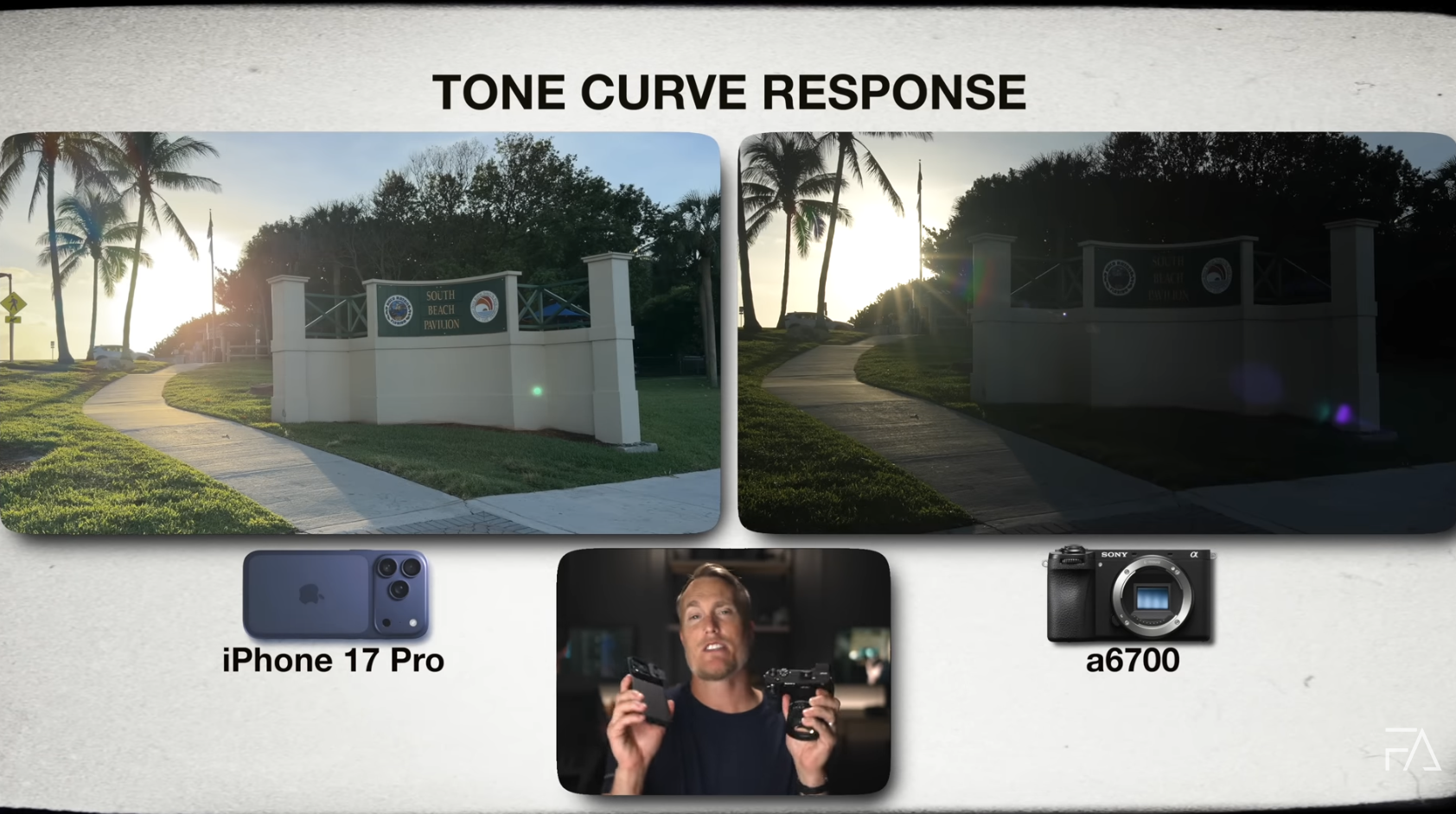
5.0 Ergonomics and User Experience (UX)
For a professional or enthusiast, the physical handling and user interface of a camera are as critical as its image output. This section evaluates the ergonomic design, controls, and overall user experience that define how it feels to operate each device.
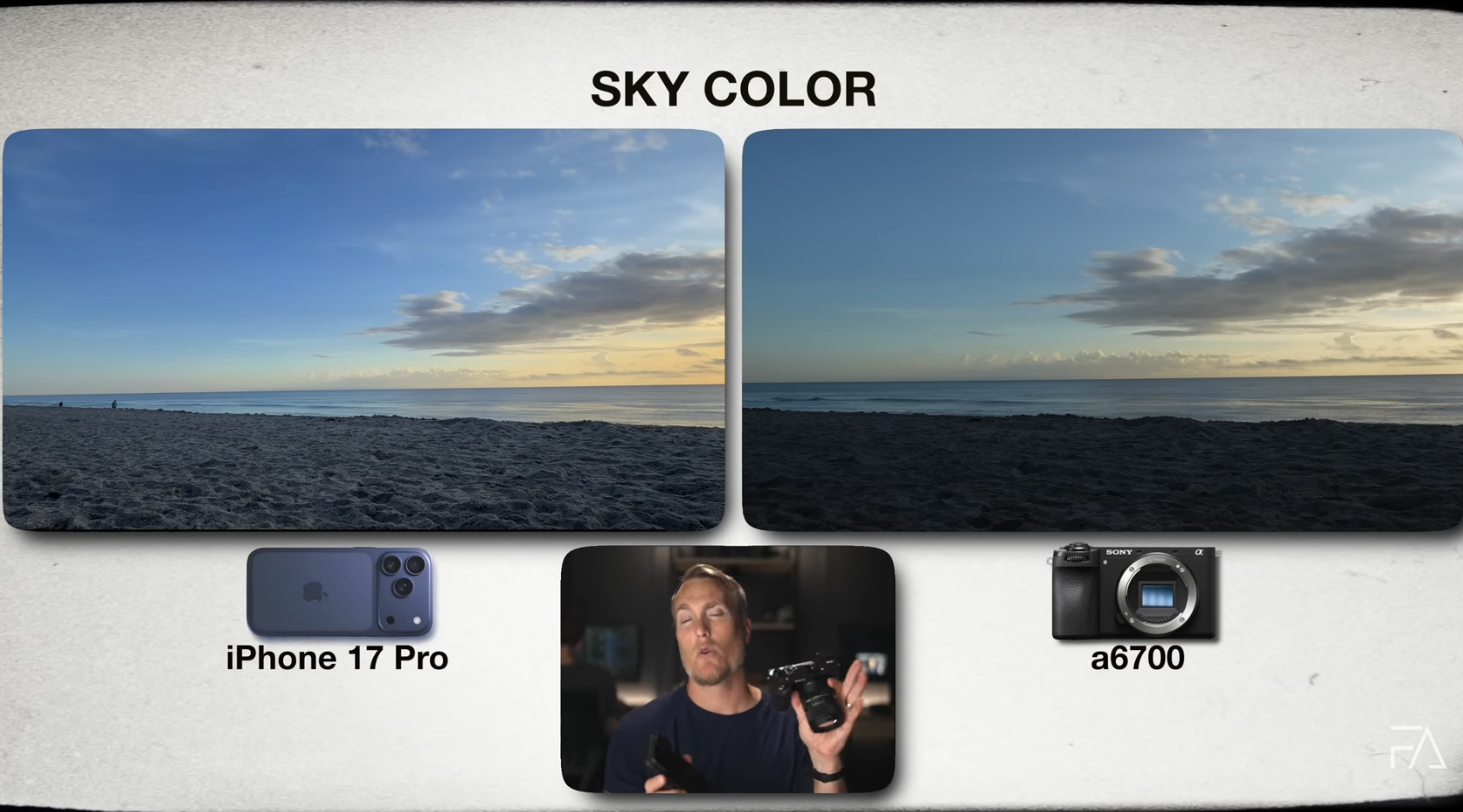
5.1 Physical Design and Handling
• Apple iPhone 17 Pro: The design is described as prioritizing "function-over-form," featuring a new aluminum unibody. Reviewers have characterized it with terms like "clunky, unfinished-looking design" and noted its increased weight compared to previous models. User interaction is primarily driven by the touchscreen, supplemented by a new physical "Camera Control" button for capturing images and adjusting settings.
• Sony a6700: Constructed from magnesium alloy, the a6700 is praised for its improved ergonomics, featuring dedicated front and rear command dials for direct control over exposure settings. It also includes a fully articulating touchscreen, which is ideal for vlogging and flexible shooting angles. However, reviews cite two primary ergonomic complaints: the low-resolution 2.36M-dot EVF, which is considered subpar by modern standards, and the lack of an AF joystick, which can make selecting focus points less intuitive.

5.2 Software Interface and Workflow
• Apple iPhone 17 Pro: The user experience is defined by the deeply integrated iOS 26 Camera app. While described as beautiful, the launch version was reported to be buggy, with users experiencing issues like "distorted images and the camera app freezing." The workflow is seamless and mobile-first, allowing for immediate editing and sharing directly from the device.
• Sony a6700: The a6700 relies on a traditional camera menu system, which reviewers note is "vastly improved" over previous Sony iterations. The workflow is hardware-centric, requiring the transfer of files from the single SD card slot or via the 5Gbps USB-C port to a computer for post-processing and editing, a standard practice for dedicated camera users.
These hardware, performance, and usability factors combine to serve two distinct user profiles, which will be synthesized in the conclusion.
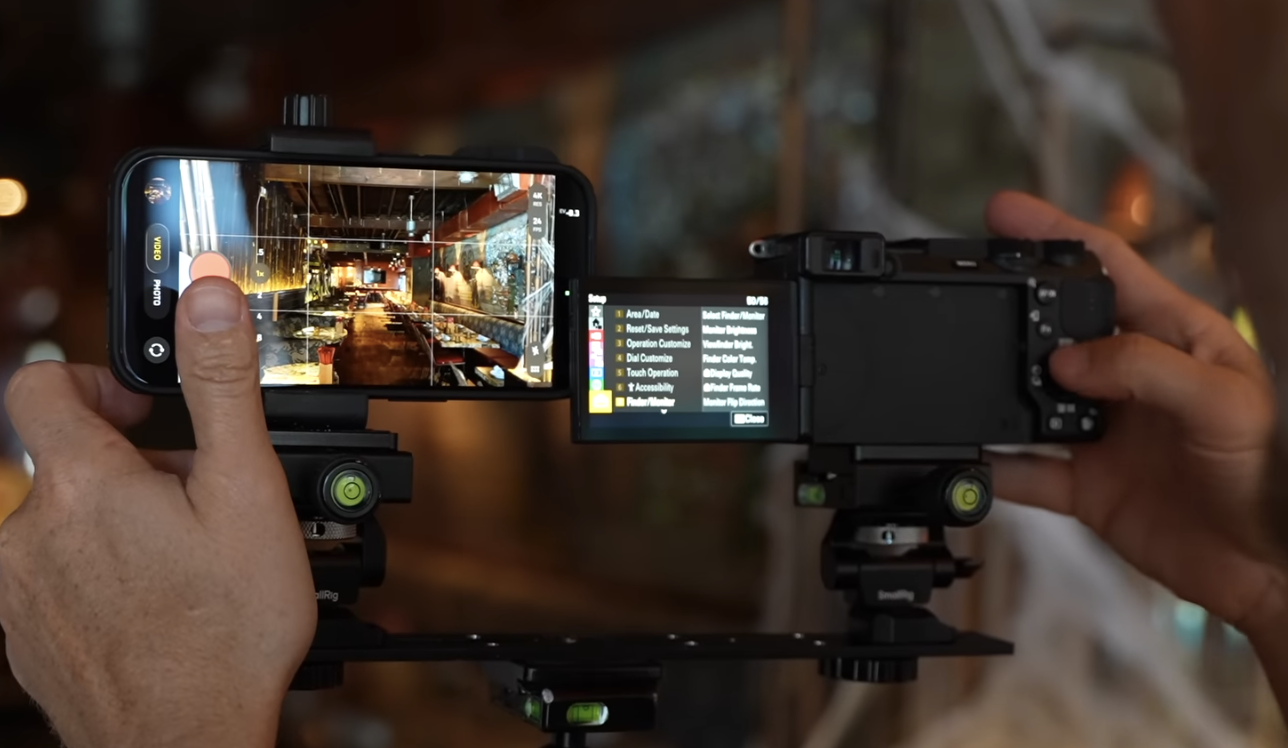
6.0 Conclusion: Strategic Synthesis and Market Positioning
This analysis confirms that the iPhone 17 Pro and Sony a6700 are not direct competitors but are instead leaders in their respective domains, defining the poles of the modern imaging market. The former champions the power of computational integration within a closed, mobile-first ecosystem, while the latter champions the flexibility of hardware and optical customization within an open, traditional framework.

6.1 Defining the User and Use Case
The ideal user and primary use case for each device can be clearly defined based on the preceding analysis.
• iPhone 17 Pro: This device is ideal for the user who demands maximum portability and convenience without compromising on high-end imaging and video capabilities. This user prioritizes computational power, a seamless software ecosystem, and an "all-in-one" solution for content creation, from capture to editing and sharing.
• Sony a6700: This camera is ideal for the dedicated enthusiast or professional who requires the creative flexibility of an interchangeable lens system and best-in-class autofocus tracking. This user prioritizes granular physical control, optical quality, and a traditional photography/videography workflow, accepting trade-offs in size, software integration, and potential thermal limitations for ultimate versatility.

6.2 Final Verdict for Strategists
The key strategic takeaway is the clear and divergent evolution of imaging technology. Apple is aggressively pushing the boundaries of what is possible through software, processing, and deep system integration within a closed ecosystem, effectively making the hardware a vessel for its computational prowess. Meanwhile, Sony continues to refine a hardware-first, open-platform approach, focusing on best-in-class sensor technology, autofocus systems, and the optical flexibility that only an interchangeable lens system can provide. Understanding this fundamental divide is critical for navigating the future of the digital imaging industry and positioning products to meet the needs of these increasingly specialized user segments.


